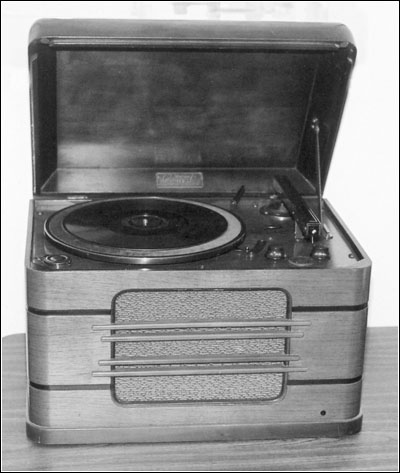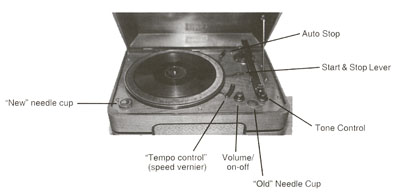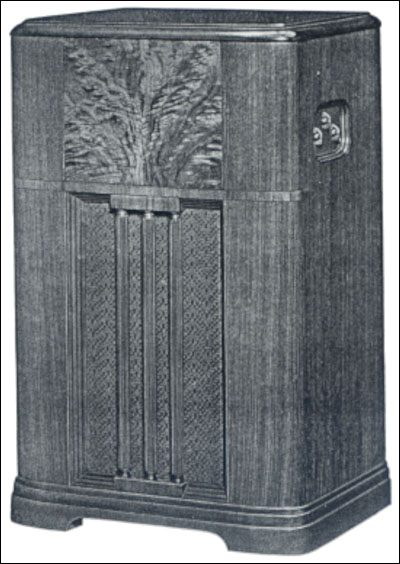Of Old Radios And Related Items--Published Monthly
The Magnavox Company
By John Eckland
Web Edition
The following article follows the Magnavox Company largely from the 1930s through the 1950s. As he did in his earlier article on the Remler 88 (see A.R.C., May 2007) John Eckland draws our attention to early efforts to improve the fidelity of speakers, and in the case of Magnavox, to combine radios and phonographs in both table and console models. (Editor)
Magnavox, a company founded by Peter Jensen and Edwin S. Pridham in 1917, was the sole manufacturer of "moving coil" horn loudspeakers, which the two had invented. Located originally in Napa, and later in Oakland, California, the company made public address systems under the Magnavox "Telemegafone" name. These were manufactured from the late teens through the mid-1920s. Also manufactured in the Oakland plant in the 1920s were European-styled telephones, as well as portable electric heaters.
In the mid-1920s, Magnavox made radios, some of which contained the "workings" in a drawer. Circuits for these radios may be referenced in Rider's Volume I. Horns for radio made after 1920 were followed by paper cone loudspeakers. In fact, from the mid-1920s onward, Magnavox made cone-type loudspeakers exclusively, with the main speaker manufacturing plant located in Chicago by 1930.
Somewhere around 1930 the company moved from Oakland, California, to Fort Wayne, Indiana. About the same time, it purchased the Mershon Condenser Co., a well-known manufacturer of quality electrolytic condensers.
Figure 1. The tabletop Magnavox Concerto model phonograph with its lid in the raised position.In addition, Magnavox purchased the Electro-Acoustic Products Company, which became a subsidiary in the mid-1930s. This company made sales presentation phono/filmstrip projector units called "Illustravox." This product put Magnavox back into the consumer electronics business with the introduction of radios and phonographs for the 1936 year.
The "Concerto"
Magnavox made a tabletop high fidelity phonograph called the "Concerto," shown in Figures 1 and 2 (see print version). This set features a single-ended 2A3 amplifier, an Astatic B-2 crystal pickup in a straight tonearm assembly, plus a special 8-inch electro-dynamic speaker with an aluminum voice coil. The 78 rpm turntable is a governor-controlled, adjustable speed General Industries Green-Flyer. Figure 3 shows a close-up of the turntable, tone arm, and controls.
At the time, there was nothing else on the market that could compare to the performance of this phonograph. Later on, two competitors produced a phonograph of similar performance -- the RCA R-98 and the Ansley Dynaphone. Both manufacturers used amplifiers employing a pair of push-pull Type 2A3 tubes.
The "Symphony"
Also for the 1936 year, Magnavox made a floor-standing console phonograph called the "Symphony," as shown in Figure 4 (see print version). It uses the same turntable and arm as the "Concerto"; however, it was available also with a record-changer as an option.
The amplifier uses a 25-watt, beam power, a push-pull Type 6L6 amp, and an interstage transformer with a Type 6C5 driver tube.
Figure 3. A close-up shows the details of the record player, including the needle cups, speed control and audio controls.The speaker system is unusual in that it uses a pair of 12-inch, vertically arranged (one above the other), electro-dynamic speakers, voice-coils hooked in parallel. The upper treble speaker uses a hard grey paper cone, while the lower speaker uses a softer black paper cone more suitable for lower frequencies. The speaker compartment is, as is usual with Magnavox sets, open-backed.
Both the Concerto and Symphony cabinets are streamlined, Art Deco "radio" types of furniture. Capehart was a high-end radio-phonograph manufacturer in Fort Wayne also, and its conservative cabinet designs may possibly have rubbed off on Magnavox's later cabinet designs. Teamed up with Drexel, Magnavox took on the styles of traditional furniture design, such as Duncan Phyfe and others.
The various record changers used over the years include mechanisms made by General Industries, Garrard, Webster Corporation and Collaro of England. The Magnavox/Collaro relationship lasted many years.
The quality of the radio and amplifier chassis is very good. Parts are well spread out over the foundation. Large high-"Q" coils are used and component quality is very good. The mechanical design of the tuner is simple and durable -- no belts to break, and dial cord, if used, is laid out simply for expedient restringing. Usually, direct drive is employed with a planetary drive, coupled with a large, ergonomically correct tuning knob.
From 1936 to 1959 Magnavox continued to use the twin 12-inch loudspeaker complement as on the original Symphony model. The most commonly used output tubes in Maganvox sets were Types 6V6 and 6L6. They were often used in push-pull parallel.
Figure 5. The Symphony console with an automatic record changer is housed in a slightly different cabinet to accommodate the record changer.The first FM tuner introduced in 1941 by Magnavox was the CR-158. It tuned from approximately 42 to 50 megacycles.
The Windsor Imperial
The top-of-the-line Magnavox was the Windsor Imperial. It was manufactured from the late 1930s to the early 1950s. This model featured Drexel cabinetry, and in later iterations, a fully divided high fidelity speaker system. Stephens Tru-Sonic of Culver City, California, provided the 8-cell horn tweeter. Magnavox provided a 15-inch woofer, and the crossover frequency is 800 cycles. The Stephens tweeter was supplied with either a field coil or an Alnico magnet in later production Windsors.
The first record changer used was a Webster 78 rpm model, followed by a 2-speed model, and finally, a 3-speed changer in the last of the Windsors. As an option, some of the Websters are fitted with plug-in headshells to accommodate standard groove and microgroove records. Also available were GE reluctance-type magnetic cartridges to fit into these headshells.
FM tuners were usually in operation in earlier Windsors; however, they became integrated with AM and shortwave tuner in last production runs of the set in the late 1940s.
The cabinet of the Windsor is nice in that it will accommodate a large number of record albums. In 1948, an upper unit was available that would provide further storage room. It also had room to accommodate the new Magnavox 10-inch television sets.
Mounting Tuners and Amplifiers
The mounting of Magnavox tuners and amplifiers was facilitated in some cases through the use of a novel "shock-mounted" sled arrangement. Unplugging the cables and removing just two screws allows the tuner to be extracted in short order for service. Another nice feature is that the tuner faceplate and knobs are integral to same, allowing for expedient removal.
The brilliant mechanical engineers responsible for this good design must have left the company, for, after 1950, the tuner was a nuisance to remove from the cabinet. Many screws holding the back have to be removed just to gain entry to the rear of the set. Underwriters Laboratory may have had something to do with this change of design. Also, due to the fixed faceplate, the knobs have to be removed before the tuner can be extracted.
Magnavox used a push-button sweep dial of novel mechanical design throughout the 1940s. This was an excellent and reliable design, given its moderate degree of complexity.
The Concert Grand
Finally, the last top-of-the-line combo from Magnavox would have to be the Concert Grand, popular from the early to late 1950s in various iterations, finally ending up as a stereo model in 1959. Originally selling for $800, it uses the British Collaro record changer or optional Collaro manual turntable, both with plug-in headshells to accommodate standard and microgroove records.
The Concert Grand also features bi-amplification with push-pull, parallel 6V6 tubes -- six for the 30-watt bass channel and two for the treble channel (10 watts). The silver Hammerite painted amplifier with eight Type 6V6 tubes looks impressive.
The speaker complement features a 15-inch woofer, a 12-inch mid-range speaker and two Jensen horn tweeters. Except for the perforated masonite back, the speaker cabinet is essentially "open-backed."
[For more information about the early years of the Magnavox Company, see Alan Douglas' Radio Manufacturers of the 1920's, Vol. 2.]
References:
Magnavox Brochure and Service Manual, 1936.
Morgan, Jane. "The First Fifty Years," Electronics in the West, Sept. 1967.
Radio Craft, Vol. IX, No. 9, 1938.
Science and Invention, August, 1920.
(John Eckland, P.O. Box 1731, Palo Alto, CA 94302-1731)
John Eckland's interest in radio goes back to 1961 when he purchased a Philco 71 Baby Grand for one dollar at a Goodwill Store in Santa Cruz, California. He has been collecting and repairing radios ever since.
| [Free Sample] [Books, etc., For Sale] [Subscribe to A.R.C./Renew] [Classified Ads] [Auction Prices] [Event Calendar] [Links] [Home] [Issue Archives] [Book Reviews] [Subscription Information] [A.R.C. FAQ] URL = http://www.antiqueradio.com/Sep07_Eckland_Magnavox.html Copyright © 1996-2007 by John V. Terrey - For personal use only. Last revised: August 30, 2007. For Customer Assistance please contact ARC@antiqueradio.com or call (866) 371-0512 toll free
Antique Radio Classified |


